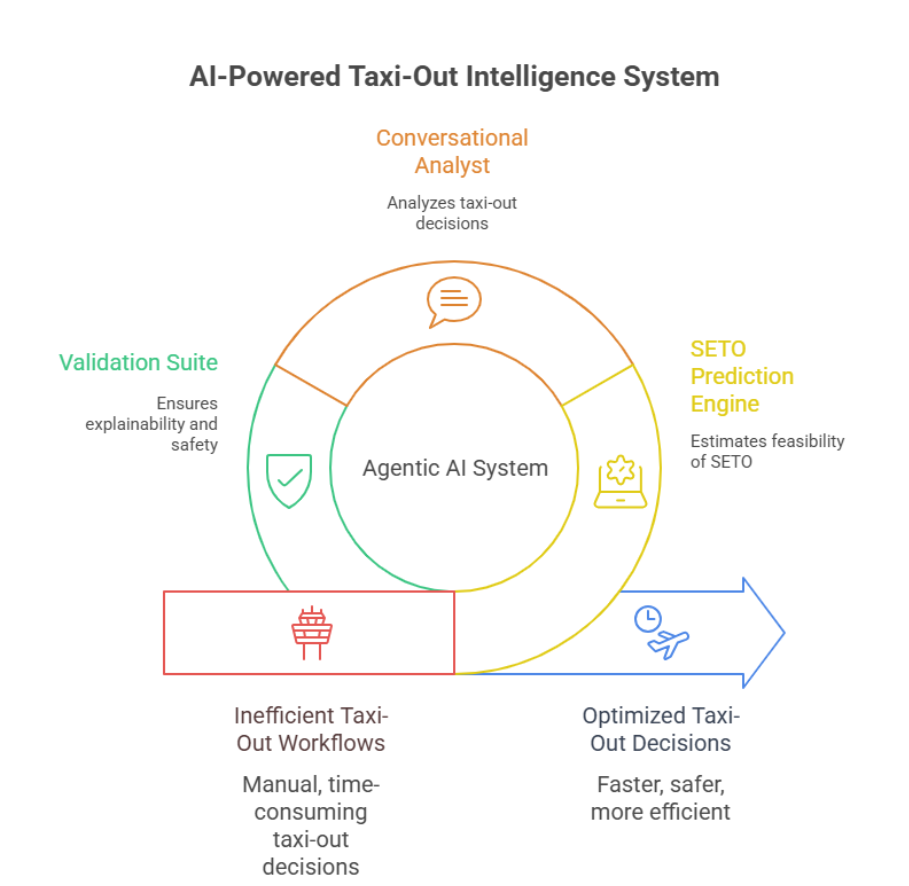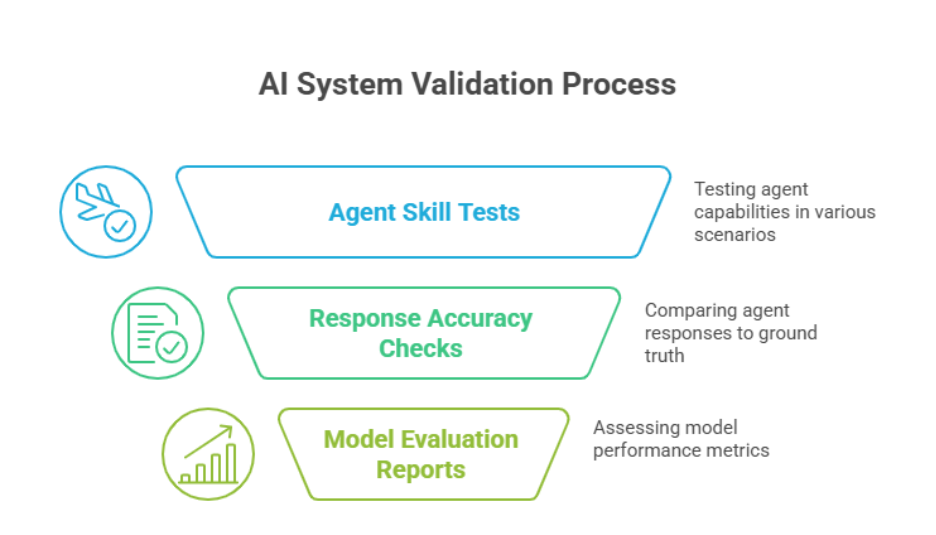Maintaining trust in an airline’s fuel and sustainability program starts with the decisions made on the ground. Traditional rule-based and manual taxi-out practices haven’t kept pace with traffic growth, operational complexity, and rising sustainability expectations.
To tackle this, TripAI partnered with GoML to build an agentic, data-driven layer centered on conversational AI for airlines that predicts Single Engine Taxi Out (SETO) opportunities and explains Engine-Out Taxi-Out (EOTO) behavior in real time.
The problem: static taxi-out decisions limit fuel savings and insight
Taxi-out is a short phase of flight with a disproportionate impact on fuel burn, emissions, and on-time performance, yet it was still largely governed by static SOPs, fragmented tools, and manual judgment across TripAI’s airline partners. Dispatchers, pilots, and ground teams relied on load sheets, METAR reports, and experience to decide when Single Engine Taxi Out (SETO) or Engine-Out Taxi-Out (EOTO) could be safely used, but they lacked a unified system that evaluated all relevant parameters together, explained why a particular taxi-out configuration was or wasn’t feasible, or surfaced trend-level insights across fleets, airports, and time periods.
As a result, safe SETO opportunities were sometimes missed, drops in SETO usage for specific fleets or stations were hard to diagnose, and manual review of taxi-out logs, load sheets, and compliance data remained slow and inconsistent. To deliver a reliable, scalable decision layer, TripAI needed conversational AI for airlines that could predict SETO feasibility from historical operations data, make EOTO behavior explainable in clear operational language, and help teams understand not just what happened, but why it happened and what to do next.
The solution: an agentic taxi-out intelligence system powered by conversational AI for airlines
GoML worked with TripAI to build a modular, agentic AI system tailored for SETO and taxi-out workflows. Powered by AWS (Sagemaker, ECS, Lambda), Amazon Bedrock, and GoML's proprietary AI Matic delivery framework, the solution brings together a SETO prediction engine, a conversational analyst for taxi-out decisions, and a validation suite that keeps the system explainable and safe.
SETO prediction engine
The teams built a predictive ML model that estimates the feasibility of SETO for each taxi-out scenario.
The SETO engine evaluates individual flights and decides whether single-engine taxi-out is feasible under current conditions. For every flight, it returns:
- A SETO feasibility recommendation
- A confidence score
- Feature contribution signals explaining what influenced the decision
Inputs
- Load sheet parameters (weight and balance, payload distribution)
- METAR-derived weather factors (wind, visibility, runway conditions)
- Taxi-out logs and route characteristics
- Historical pilot behavior and EOTO compliance data
Pipeline and infrastructure
- AWS Sagemaker for training and batch inference
- AWS S3 for feature, dataset, and model artifact storage
- AWS ECS and Lambda for orchestrating data prep, training, and scheduled scoring jobs
- GoML boilerplates for MLOps and Agentic AI to structure feature engineering, experiment tracking, and deployment
Evaluation
- Evaluation templates generate performance reports (accuracy, precision/recall for SETO vs non-SETO, false negative analysis)
- Operational views highlight how well the model captures real SETO opportunities, especially with limited historical data

Taxi-out conversational analyst
TripAI already had an operational assistant on its iAssist platform. By using the AI Matic agent boilerplate, GoML and TripAI turned it into a conversational AI for airlines focused on taxi-out and EOTO.
The enhanced agent acts as a taxi-out analyst that:
- Reads load sheets, METAR data, pilot inputs, and aircraft manual PDFs
- Explains whether SETO is recommended for a specific flight
- Brings together model outputs and operational rules in natural language
- Answers EOTO performance and trend questions at fleet and network scale
Context-aware SETO guidance
- Returns a clear decision: “SETO recommended / not recommended”
- Justifies the recommendation with safety and performance factors: runway length, contamination, crosswind limits, aircraft weight, or weather constraints
- Always prioritizes safety over fuel savings
EOTO performance insights
- Responds to questions like:
- “On which flights did we perform EOTO last week from GRU?”
- “Why did SETO percentages drop on Azul A320 flights this month?”
- “What are the top reasons SETO wasn’t used when it was technically feasible?”
- Uses retrieval flows to interpret telemetry, SETO/EOTO compliance records, and load-sheet patterns
Trend detection and remediation recommendations
- Highlights airports where SETO is under-used
- Detects patterns like specific times of day or weather profiles tied to reduced SETO adoption
- Suggests interventions such as targeted crew briefings, SOP refinements, or tailored training
How AI Matic guided the conversational AI for airlines
Built on Amazon Bedrock LLMs with a Python backend, the agent uses AI Matic for:
- Tool-calling patterns (querying flight data, invoking the SETO model, fetching logs)
- Role-specific prompt templates such as “data analyst agent,” “safety-aware advisor,” and “ops explainer”
- Guardrails that ensure the agent clearly explains when EOTO has not been performed
- Uses precise, audit-ready language suitable for ops and compliance reviews
- Maintains safety as the primary objective in every recommendation
The agent is delivered through Chainlit/Streamlit, giving TripAI and Azul SMEs an interactive, iterative way to test, refine, and adopt this conversational AI for airlines in day-to-day workflows.

Testing and validation suite
To avoid deploying a black-box system, the POC also included a dedicated testing and validation layer, built on the AI Matic evaluation and testing boilerplate.
The validation suite is used to test both the SETO prediction engine and the conversational AI for airlines before and during deployment.
Agent skill tests
- Synthetic and real scenarios covering multiple aircraft types, airports, weather conditions, and loading patterns
- Queries such as:
- “Explain why flight AZUL123 did not use SETO yesterday.”
- “Compare SETO feasibility for these 10 flights and summarize trends.”
Response accuracy checks
- Agent responses are compared to ground-truth datasets
- Outputs are validated via direct database queries
- SMEs review samples to assess correctness, clarity, and safety posture
Model evaluation reports
- Standard performance metrics for the SETO classifier
- Operational metrics like:
- Percentage of correctly identified SETO opportunities
- Impact of limited historical data availability
- Safe confidence thresholds for decision support

The impact: explainable taxi-out optimization, powered by conversational AI for airlines
Within the constraints of a focused POC and Azul-only data, TripAI and GoML established a strong foundation for measurable operational improvements:
- Up to 28% more feasible SETO opportunities identified, giving airlines a clearer roadmap for future fuel savings.
- Around 35% less manual analysis effort on SETO/EOTO investigations, with teams relying on the conversational AI instead of spreadsheets.
- Approximately 22% faster taxi-out performance reviews, driven by pre-defined queries, reusable scenarios, and AI Matic-based evaluation reports.
The system gives airlines a path toward smarter, more consistent taxi-out decisions, supporting fuel savings and emissions reduction while preserving safety and regulatory alignment.
Lessons for airlines and aviation platforms
Common pitfalls to avoid
- Relying solely on static rules and manual judgment for SETO/EOTO
- Treating taxi-out as a fixed cost instead of a controllable lever for fuel and emissions
- Deploying AI without explainability, validation, or SME involvement
Tips for product and engineering teams
- Start with a focused POC that combines a prediction engine, conversational AI for airlines, and a robust validation suite.
- Use frameworks like AI Matic and boilerplates for ML pipelines, agents, and evaluation to move fast without sacrificing quality.
- Design your conversational agent to be analytical and safety-aware, prioritizing clear explanations, trend insights, and actionable recommendations.
Ready to bring conversational AI for airlines into your taxi-out operations?
Let GoML help you build an agentic AI layer on top of your existing operational data. With AI Matic and domain-ready boilerplates, you can predict SETO opportunities, make EOTO behavior explainable, and move toward safer, greener taxi-out operations across your network.





